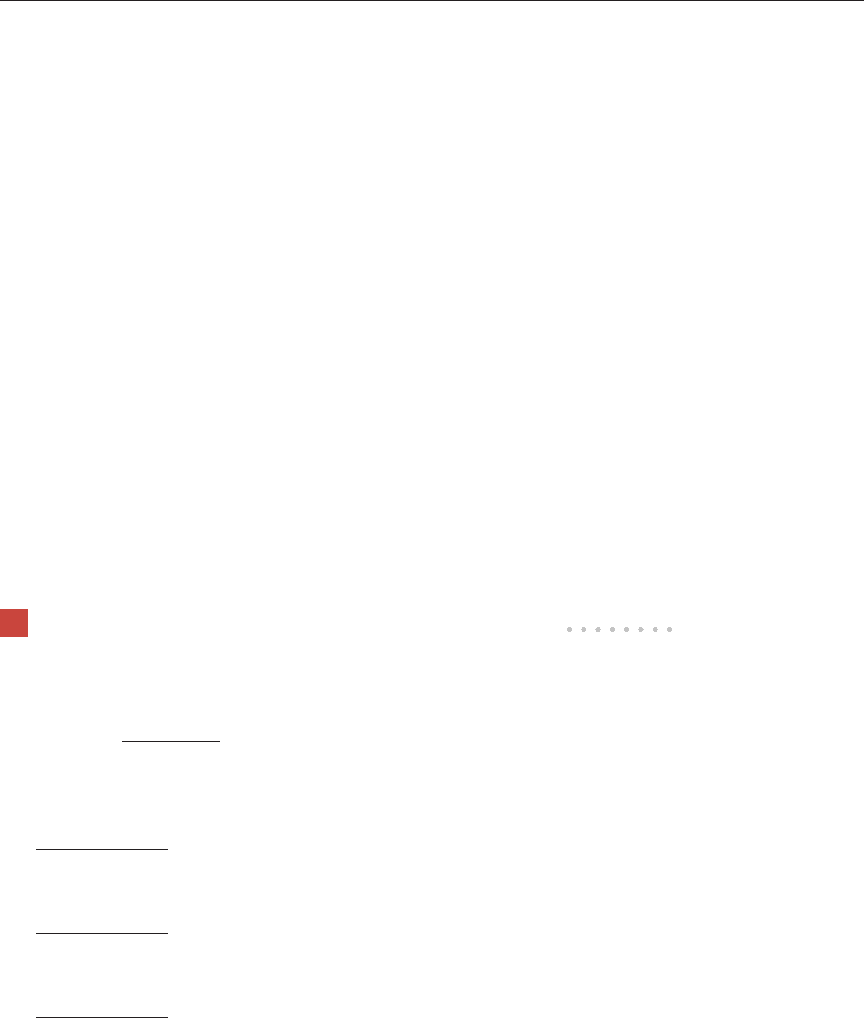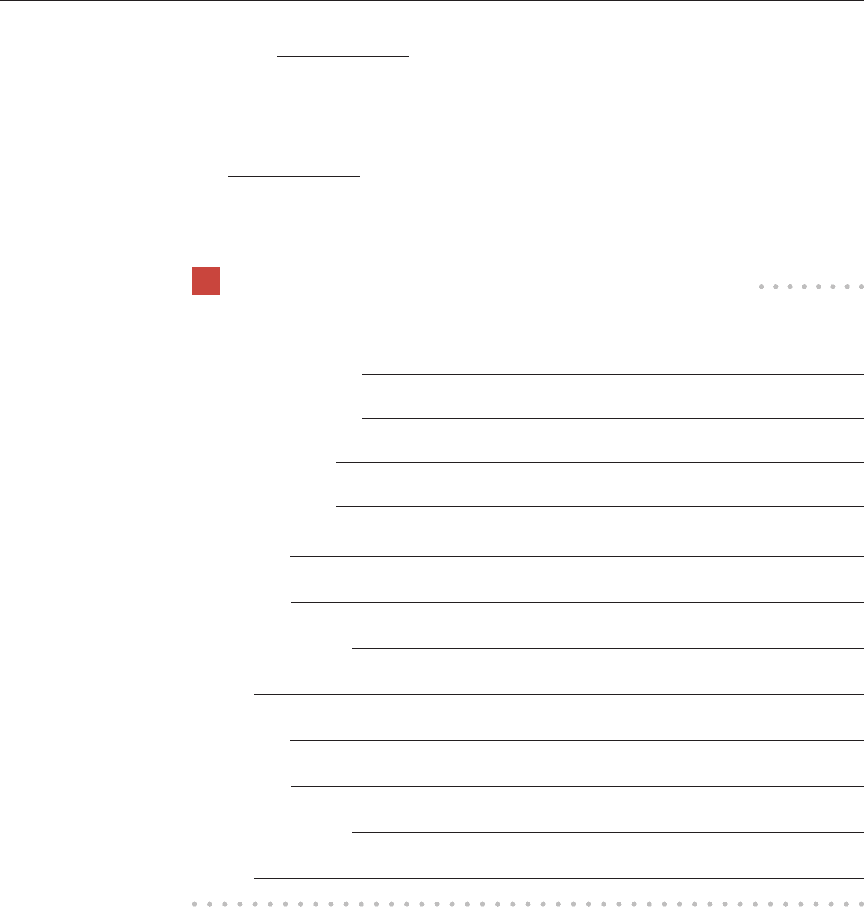Anker Susan. Real Essays with Readings with 2009 MLA Update
Подождите немного. Документ загружается.


EDITING ESSAYS
Chapter 32 • Sentence Variety 567
PRACTICE 4 JOINING IDEAS USING AN -ING VERB FORM
Combine each pair of sentences into a single sentence by using an -ing verb
form. Add or delete words if necessary.
Imagining that
EXAMPLE: Many fans of rap music imagine it is a recent
development. They are not aware that the roots of this
music go back centuries.
1. Folk poets wandered from village to village in West Africa hundreds of
years before the birth of the United States. They rhythmically recited sto-
ries and tales with the accompaniment of a drum and a few instruments.
2. Rap music uses rhymes and wordplay with a rhythmic delivery to build
on this heritage. Its lyrics often deal with matters of race, socioeconomic
class, and gender.
3. Many fans trace the beginning of modern-day rap to a Jamaican immi-
grant to the Bronx in New York. They still revere Kool Herc, a DJ in the
1970s who originated the new sound in America.
4. Kool Herc recited lyrics to go along with the songs that he was playing as
a DJ. He introduced this innovative music at private parties and then later
at well-known dance halls.
5. In the 1980s, rappers’ lyrics focused on sharp sociopolitical content. They
captivated listeners with increasingly creative wordplay.
6. Rap songwriters developed a rougher, more sinister edge in the 1990s.
They began narrating personal street experiences mixed with social com-
mentary.
7. Today, rap music has branched out in several directions. Today, it has
southern, northern, midwestern, and even international rap forms along-
side the more established styles from the East and West coasts.
^
^
, many fans
ANK_47574_32_ch32_pp563-581 r5 ko.indd 567ANK_47574_32_ch32_pp563-581 r5 ko.indd 567 10/29/08 10:21:23 AM10/29/08 10:21:23 AM

EDITING ESSAYS
568 Part Five • Other Grammar Concerns
8. Perhaps consciously and perhaps not, rappers extensively use forms of
wordplay that are also found in classical poetry. They call on such literary
devices as double meanings, alliteration, similes, and metaphors.
9. Rap artists emphasize frequently the themes of wealth and class. Nearly
all popular rappers in the United States are African American.
10. Rap has gained a solid foothold in American culture. It is now widely
accepted as a form of mainstream American music.
PRACTICE 5 JOINING IDEAS USING AN -ING VERB FORM
Fill in the blank in each sentence with an appropriate -ing verb form. There
are many possible ways to complete each sentence.
EXAMPLE:
Owning
the rights to the character Spider-Man, Marvel
Enterprises has been making big money lately.
1. from losses of tens of millions of dollars a year, Marvel
now turns a profi t of more than $150 million a year, thanks to Spider-
Man.
2. Marvel dominates the comic-book market, sixty comic
books a month.
3. 83 percent of its profi ts from licensing its characters for
fi lms and related merchandise, Marvel makes only 15 percent of its profi ts
from comic-book sales.
4. Marvel keeps tight control of the characters it licenses to fi lmmakers,
no costume changes or added superpowers without Mar-
vel’s approval.
5. any fi lm studio from having Spider-Man kill anyone, for
example, Marvel maintains the character as it believes he should be.
ANK_47574_32_ch32_pp563-581 r5 ko.indd 568ANK_47574_32_ch32_pp563-581 r5 ko.indd 568 10/29/08 10:21:23 AM10/29/08 10:21:23 AM

EDITING ESSAYS
Chapter 32 • Sentence Variety 569
PRACTICE 6 JOINING IDEAS USING AN -ING VERB FORM
Write two sets of sentences, and join each set using an -ing verb form.
EXAMPLE: a.
Teresa signed on to eBay.com.
b.
She used her password.
COMBINED:
Using her password, Teresa signed on to eBay.com.
Teresa signed on to eBay.com using her password.
1. a.
b.
COMBINED:
2. a.
b.
COMBINED:
Join Ideas Using an -ed Verb Form
Another way to combine sentences is to turn one of them into a phrase
using an -ed verb form (such as waited or walked ). You can join sen-
tences this way if one of them has a form of be as a helping verb along with
the -ed verb form.
TWO SENTENCES Leonardo da Vinci was a man of many talents. He
was noted most often for his painting.
JOINED WITH -ED Noted most often for his painting, Leonardo da
VERB FORM Vinci was a man of many talents.
To combine sentences this way, drop the subject and the helping verb
from a sentence that has an -ed verb form. You now have a modifying
■ For more on
helping verbs, see
Chapters 22, 26,
and 33.
ANK_47574_32_ch32_pp563-581 r5 ko.indd 569ANK_47574_32_ch32_pp563-581 r5 ko.indd 569 10/29/08 10:21:24 AM10/29/08 10:21:24 AM

EDITING ESSAYS
570 Part Five • Other Grammar Concerns
phrase that can be added to the beginning or the end of the other sen-
tence, depending on what makes the most sense.
Leonardo was interested in many areas.
/
He investigated problems of
geology, botany, mechanics, and hydraulics.
If you add a phrase that begins with an -ed verb form to the beginning
of a sentence, put a comma after it. Be sure the word that the phrase mod-
ifi es follows immediately, or you will create a dangling modifi er. Some-
times, you will need to change the word that the phrase modifi es from a
pronoun to a noun, as in the previous example.
PRACTICE 7 JOINING IDEAS USING AN -ED VERB FORM
Combine each pair of sentences into a single sentence by using an -ed verb
form.
Hatched
EXAMPLE: Alligators are hatched from eggs when they are only a
, alligators
few inches long.
/
Alligators can reach a length of ten feet or more as
adults.
1. An alligator was spotted in a pond in Central Park in New York City.
Many New Yorkers refused to believe in the existence of the alli-
gator.
2. Alligators were released by their owners for growing too large to be pets.
These alligators were sometimes said to be living in New York City sewers.
3. Rumors were believed by some gullible people. The rumors about giant
sewer alligators were untrue.
4. The story of the alligator in Central Park was denied by city offi cials. The
story sounded like another wild rumor.
5. Central Park alligator sightings were reported by several New Yorkers.
The sightings were confi rmed when a television news crew fi lmed a reptile
in the pond.
Interested
^
, Leonardo
^
^
^
■ For more on fi nd-
ing and correcting
dangling modifi ers,
see Chapter 29.
ANK_47574_32_ch32_pp563-581 r5 ko.indd 570ANK_47574_32_ch32_pp563-581 r5 ko.indd 570 10/29/08 10:21:24 AM10/29/08 10:21:24 AM

EDITING ESSAYS
Chapter 32 • Sentence Variety 571
6. A professional alligator wrestler was hired to catch the reptile. He came
to New York from Florida.
7. The pond in Central Park was surrounded by news cameras and curious
onlookers. It was brightly lit just before 11:00 p.m. on the day the alliga-
tor wrestler arrived.
8. The creature was captured in just a few minutes by the alligator wrestler’s
wife. The so-called alligator turned out to be a spectacled caiman, a spe-
cies native to Central and South America.
9. Some New Yorkers were surprised to fi nd that the caiman was only two
feet long. They may have felt a bit foolish for expecting to see a giant
alligator in the park.
10. The caiman was removed from Central Park. It soon found a home in a
warmer climate.
PRACTICE 8 JOINING IDEAS USING AN -ED VERB FORM
Fill in the blank in each sentence with an appropriate -ed verb form. There are
several possible ways to complete each sentence.
EXAMPLE:
Enjoyed
by many people around the world, online
gambling is an increasingly popular recreational
option.
1. regularly by Europeans, this venue for gambling is more
diffi cult for Americans to access.
2. by some U.S. states, online gambling is a major worry of
the government.
3. that Internet gambling can be used for hiding large
exchanges of money, the U.S. Justice Department has asked major Inter-
net search engines to remove advertising for online gambling operations.
ANK_47574_32_ch32_pp563-581 r5 ko.indd 571ANK_47574_32_ch32_pp563-581 r5 ko.indd 571 10/29/08 10:21:24 AM10/29/08 10:21:24 AM

EDITING ESSAYS
572 Part Five • Other Grammar Concerns
4. Also to legalizing online gambling in the United States,
some antigambling activists think the speed of the Internet makes it more
likely for problem gamblers to give in to their addiction.
5. a harmless pastime by some, easy-access online gambling
can arguably ruin even more lives than it already has.
PRACTICE 9 JOINING IDEAS USING AN -ED VERB FORM
Write two sets of sentences, and join them using an -ed verb form.
EXAMPLE: a.
Lee is training for the Boston Marathon.
b.
It is believed to have the most diffi cult hill to run.
COMBINED:
Lee is training for the Boston Marathon, believed to have the
most diffi cult hill to run.
1. a.
b.
COMBINED:
2. a.
b.
COMBINED:
Join Ideas Using an Appositive
An appositive is a phrase that renames a noun. Appositives, which are
nouns or noun phrases, can be used to combine two sentences into one.
TWO SENTENCES Elvis Presley continues to be popular many years after
his death. He is “the King.”
ANK_47574_32_ch32_pp563-581 r5 ko.indd 572ANK_47574_32_ch32_pp563-581 r5 ko.indd 572 10/29/08 10:21:24 AM10/29/08 10:21:24 AM

EDITING ESSAYS
Chapter 32 • Sentence Variety 573
JOINED WITH Elvis Presley, “the King,” continues to be popular
AN APPOSITIVE many years after his death.
[The phrase “the King” renames the noun Elvis Presley.]
To combine two sentences this way, turn the sentence that renames the
noun into a phrase by dropping its subject and verb. The appositive phrase
can appear anywhere in the sentence, but it should be placed before or after
the noun it renames. Use a comma or commas to set off the appositive.
Millions of people visit Elvis’s home each year. It is called Graceland.
PRACTICE 10 JOINING IDEAS USING AN APPOSITIVE
Combine each pair of sentences into a single sentence by using an appositive.
Be sure to use a comma or commas to set off the appositive.
EXAMPLE: William Shakespeare was famous and fi nancially com-
fortable during his lifetime. Shakespeare was one of the greatest
writers in the English language.
1. Shakespeare grew up in Stratford, England. He was the son of a former
town leader.
2. Shakespeare attended the local grammar school until his father could no
longer afford it. His father was a poor manager of money.
3. In 1582, Shakespeare, just eighteen, married twenty-six-year-old Anne
Hathaway. She was a farmer’s daughter.
4. Three years later, he left for London. London was the center of England’s
theater world.
5. Young Shakespeare was once a simple country boy. He soon became
involved in acting, writing, and managing for one of London’s theater
companies.
6. By 1592, he was famous enough to be criticized in writing by one of the
leading playwrights of the time. This playwright was Robert Greene.
, Graceland,
^
, one of the greatest writers in the English language,
^
ANK_47574_32_ch32_pp563-581 r5 ko.indd 573ANK_47574_32_ch32_pp563-581 r5 ko.indd 573 10/29/08 10:21:25 AM10/29/08 10:21:25 AM

EDITING ESSAYS
574 Part Five • Other Grammar Concerns
7. Greene’s publisher soon printed a public apology for the criticism. This was
proof that Shakespeare had won the respect of some infl uential fi gures.
8. Shakespeare is said to have performed for Queen Elizabeth I. She was a
theater fan and supporter.
9. Eventually, Shakespeare returned to Stratford and purchased a large home
where he lived until his death in 1616. The house was called New Place.
10. Shakespeare remains highly popular today, and more than 250 movies
have been made of his plays or about his life. His life is a rich enough
source of drama for any movie producer.
PRACTICE 11 JOINING IDEAS USING AN APPOSITIVE
Fill in the blank in each sentence with an appropriate appositive. There are
many possible ways to complete each sentence.
EXAMPLE: My sister Clara,
a busy mother of three
, loves to watch
soap operas.
1. Clara’s favorite show, , comes on at three o’clock in
the afternoon.
2. Clara, , rarely has the time to sit down
in front of the television for the broadcast.
3. Instead, she programs her VCR, , and
tapes the show for later.
4. Clara’s husband, , used to tease her for
watching the soaps.
5. But while he was recovering from the fl u recently, he found her stack
of tapes,
, and Clara insists that he
watched every show of the previous season.
ANK_47574_32_ch32_pp563-581 r5 ko.indd 574ANK_47574_32_ch32_pp563-581 r5 ko.indd 574 10/29/08 10:21:25 AM10/29/08 10:21:25 AM

EDITING ESSAYS
Chapter 32 • Sentence Variety 575
Join Ideas Using an Adjective Clause
An adjective clause is a group of words with a subject and a verb that
describes a noun. Adjective clauses often begin with the word who, which,
or that and can be used to combine two sentences into one.
TWO SENTENCES Lorene owns an art and framing store. She is a good
friend of mine.
JOINED WITH AN Lorene, who is a good friend of mine, owns an art
ADJECTIVE CLAUSE and framing store.
To join sentences this way, use who, which, or that to replace the sub-
ject of a sentence that describes a noun that is in the other sentence. Once
you have made this change, you have an adjective clause that you can
move so that it follows the noun it describes. The sentence with the idea
you want to emphasize should become the main clause. The less impor-
tant idea should be in the adjective clause.
TWO SENTENCES Rosalind is director of human services for the town
of Marlborough. Marlborough is her hometown.
[The more important idea here is that Rosalind is director of human services. The
less important idea is that the town is her hometown.]
JOINED WITH AN Rosalind is director of human services for the town
ADJECTIVE CLAUSE of Marlborough, which is her hometown.
NOTE: If an adjective clause can be taken out of a sentence without
completely changing the meaning of the sentence, put commas around the
clause.
Lorene, who is a good friend of mine, owns an art and framing store.
[The phrase who is a good friend of mine adds information about Lorene, but it is
not essential; the sentence Lorene owns an art and framing store means almost the
same thing as the sentence in the example.]
If an adjective clause is essential to the meaning of a sentence, do not
put commas around it.
The meat was recalled for possible salmonella poisoning. I ate it
yesterday.
The meat that I ate yesterday was recalled for possible salmonella
poisoning.
[The clause that I ate yesterday is an essential piece of information. The sentence
The meat was recalled for possible salmonella poisoning changes signifi cantly with the
adjective clause that I ate yesterday.]
■ Use who to refer
to a person, which
to refer to places or
things (but not to
people), and that for
places or things.
ANK_47574_32_ch32_pp563-581 r5 ko.indd 575ANK_47574_32_ch32_pp563-581 r5 ko.indd 575 10/29/08 10:21:25 AM10/29/08 10:21:25 AM

EDITING ESSAYS
576 Part Five • Other Grammar Concerns
PRACTICE 12 JOINING IDEAS USING AN
ADJECTIVE CLAUSE
Combine each pair of sentences into a single sentence by using an adjective
clause beginning with who, which, or that.
Allergies that
EXAMPLE: Some allergies cause sneezing, itching, and watery eyes.
/
They can make people very uncomfortable.
1. Cats produce a protein. It keeps their skin soft.
2. This protein makes some people itch and sneeze. The protein is the rea-
son for most allergic reactions to cats.
3. Some cat lovers are allergic to cats. They can control their allergies with
medication.
4. Allergic cat lovers may get another option from a new company. The
company wants to create a genetically engineered cat.
5. Scientists have successfully cloned mice. Some mice have been genetically
engineered for scientifi c study.
6. Researchers may soon have the technology to clone cats. Cats could be
genetically engineered to remove the allergen.
7. Many people have allergic reactions to cats. According to cat experts,
more than 10 percent of those people are allergic to something other than
the skin-softening protein.
8. A single gene produces a cat’s skin-softening protein. Scientists are not
sure whether the gene is necessary for the cat’s good health.
9. However, owning a genetically engineered cat would allow an allergic per-
son to avoid taking allergy medications. The medications can sometimes
cause dangerous side effects.
10. Cloning and genetic engineering raise ethical questions. These are dif-
fi cult to answer.
^
ANK_47574_32_ch32_pp563-581 r5 ko.indd 576ANK_47574_32_ch32_pp563-581 r5 ko.indd 576 10/29/08 10:21:25 AM10/29/08 10:21:25 AM
